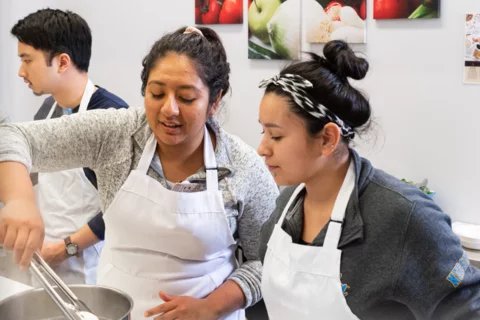The Teaching Kitchen

A small group of students were gathered around the spotless work counter, listening intently
as Culinary Arts Coordinator Julia Rhoton demonstrated how to make a quick, tasty, budget conscious and nutritious meal while letting them try their hand at replicating it.
But these students were not aspiring professional chefs. Rather, they were in the master’s program
at the UCLA School of Nursing, most hoping to treat patients in hospitals or clinics. So why were they spending their time learning about such things as knife safety and how to buy and prepare foods low in salt and sugar and high in nutrients?
“This is pretty much brand new here, how we use the kitchen to teach cooking and nutrition” to health care practitioners, said Dr. Catherine Carpenter, a faculty member of nutrition at the professor rank in the Schools of Nursing, Medicine and Public Health.
Carpenter helped develop the teaching kitchen’s program to assist nursing students in reaching patients struggling with common chronic diseases. Most of those diseases have a large nutritional component and can be managed – or reversed or prevented – with improved eating habits, she said.
She believes UCLA is one of the first nursing schools anywhere to offer such a program.
There are seven kitchen sessions, each with 10 students and organized around healthier eating for patients with a specific health problem: colon cancer, osteoporosis, mental illness, diabetes, hypertension, atherosclerosis and HIV. The nursing students are assigned to one of the sessions, then tasked with giving a report to classmates who attended one of the other sessions. Each two-hour kitchen session begins with a cooking lesson and is followed by an hour of lecture on the same condition (and yes, the students can eat what they cooked during the classroom hour.)
The kitchen session with the sweet potatoes and kale was aimed at helping colon cancer patients learn to incorporate more fiber into their diet. The classroom part, taught by Erica Lee, RD, MPH, focused on how to read food labels to make healthier choices in snack foods, cereal and the like.
“I want our nursing students to really understand the connections between food and health,” Carpenter said. She said the hands-on training not only helps the students with their own food choices but also gives them ways to make life better for their patients.
The sessions provide easy, economical cooking tips. The knife use tips, for example, can help prevent injuries and make it easier to slice through a hard-skinned vegetable like butternut squash.
During the recent kitchen session on getting colon cancer patients to eat more fiber, Chef Rhoton suggested substituting kale for the traditional basil in pesto. Expensive pine nuts could be swapped out with walnuts or almonds and leftovers could be individually frozen in ice cube trays for use in a future meal. And a blender could be used if a patient doesn’t have a food processor.
“You don’t have to have fancy equipment or expensive ingredients to make good food,” Rhoton said.
The students, while at first surprised they would be in a cooking class as part of their coursework for their master’s degree in nursing, gave the program high marks.
“I never thought we’d be cooking,” Eva Diaz said with a laugh. “But I liked the experience. I don’t cook a lot, so it helped me and I think it’s something I can use to help my patients.”
“I feel like I’m in a better position now to give good information to my patients,” said Keanna Dela Cruz.
Summer Buckley said she understands that “a big part of nursing is patient education.” And she also knows just how tempting it is, after a long, busy day, to “just go to Panda Express.” But she feels the cooking and nutrition classes have given her some good ideas for quick and nutritious meals she can make at home – and pass on to her future patients.
—by Jean Mer